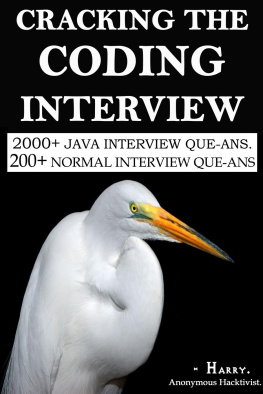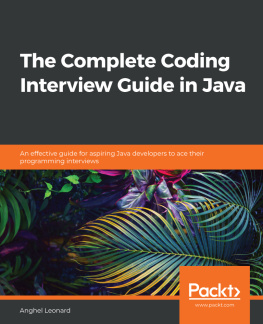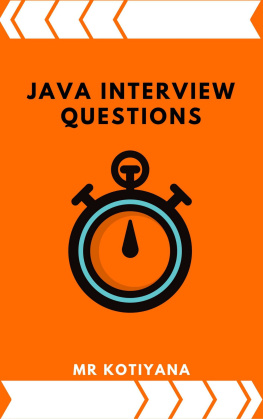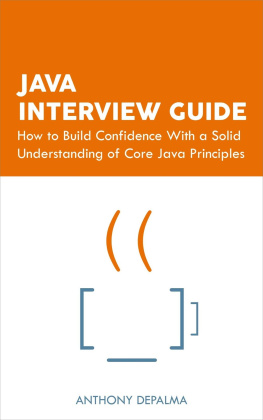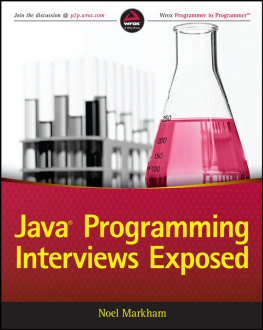Jolly M. - Java Interview Course: Prepare for your Java Interview in a day!!!
Here you can read online Jolly M. - Java Interview Course: Prepare for your Java Interview in a day!!! full text of the book (entire story) in english for free. Download pdf and epub, get meaning, cover and reviews about this ebook. year: 2020, genre: Computer. Description of the work, (preface) as well as reviews are available. Best literature library LitArk.com created for fans of good reading and offers a wide selection of genres:
Romance novel
Science fiction
Adventure
Detective
Science
History
Home and family
Prose
Art
Politics
Computer
Non-fiction
Religion
Business
Children
Humor
Choose a favorite category and find really read worthwhile books. Enjoy immersion in the world of imagination, feel the emotions of the characters or learn something new for yourself, make an fascinating discovery.

Java Interview Course: Prepare for your Java Interview in a day!!!: summary, description and annotation
We offer to read an annotation, description, summary or preface (depends on what the author of the book "Java Interview Course: Prepare for your Java Interview in a day!!!" wrote himself). If you haven't found the necessary information about the book — write in the comments, we will try to find it.
Jolly M.: author's other books
Who wrote Java Interview Course: Prepare for your Java Interview in a day!!!? Find out the surname, the name of the author of the book and a list of all author's works by series.
Java Interview Course: Prepare for your Java Interview in a day!!! — read online for free the complete book (whole text) full work
Below is the text of the book, divided by pages. System saving the place of the last page read, allows you to conveniently read the book "Java Interview Course: Prepare for your Java Interview in a day!!!" online for free, without having to search again every time where you left off. Put a bookmark, and you can go to the page where you finished reading at any time.
Font size:
Interval:
Bookmark:
The characters and events portrayed in this book are fictitious. Any similarity to real persons, living or dead, is coincidental and not intended by the author.
No part of this book may be reproduced, or stored in a retrieval system, or transmitted in any form or by any means, electronic, mechanical, photocopying, recording, or otherwise, without express written permission of the publisher.
ISBN-13: 9781234567890
ISBN-10: 1477123456
Cover design by: Art Painter
Library of Congress Control Number: 2018675309
Printed in the United States of America

- Package - Represents logical grouping of similar types into namespaces. It prevents naming collisions and access protection.
- Import - Imports the package, so that classes can be used in the code by their unqualified names.
- Class - Represents a type template having properties and methods.
- Field - Represents a member used for holding values.
- Method - Represents an operation/behavior of the class.
- Modifier - Specifies the access control level of a class and or its members.
- Parameter - Specifies the variable declared in the method definition.
- Argument - Specifies the data passed to the method parameters.
- What is a package?
- Why do you need to import packages?
- Why do you need to specify access modifiers?
- What is a static import?
- static import enables access to static members of a class without the need to qualify it by the class name.
- What is the difference between argument and parameter?

- Java compiler compiles the Java source code (.java file) into a binary format known as bytecode (.class file). Java bytecode is a platform-independent instruction set, which contains instructions (opcode) and parameter information.
- Bytecode is translated by the operating system specific Java Virtual Machine (JVM) into the platform-specific machine code.
- The Class loader in JVM loads the binary representation of the classes into memory.
- The Execution engine in JVM executes the byte code and generates operating system specific machine instructions. These machine code instructions are executed directly by the central processing unit (CPU).
- Explain the process of Java code compilation and execution?
- What is bytecode?
- What is the difference between bytecode and source code?
- What is the machine code?
- What is the difference between bytecode and machine code?
- What is JVM? Is it different or the same for different operating systems?
- What are the major components of JVM?
- What is the role of the class loader in JVM?
- What is the role of the execution engine in JVM?
- What are machine instructions?
- Primitive data types are byte , boolean , char , short , int , float , long and double .
- Primitive types always have value; if not assigned, it will have a default value.
- A long value is suffixed with L (or l) to differentiate it from int .
- A float value is suffixed with F (or f) to differentiate it from double . Similarly double is suffixed with D ( or d )
- A char is unsigned and represent Unicode values.
- When a primitive type is assigned to another variable, a copy is created.
- All non-primitive types are reference types.
- Reference types are also usually known as objects . Though reference types refer to an object in memory.
- An unassigned object of reference type will have null as the default value.
- Objects have variables and methods, which define their state and behavior.
- When a reference is assigned to another reference, both points to the same object.
- What are primitive data types?
- If a variable of primitive data type is not assigned, what does it contain?
- Why do we suffix L with long, F with Float and D with a double?
- What happens when you assign a variable of a primitive data type to another variable of the same type?
- What are the reference data types?
- What happens when you assign a variable of the reference data type to another variable of the same reference type?
- What are the differences between the primitive data types and the reference data types?
- What is the purpose of variables and methods in a reference type?
- If a variable of reference data type is not assigned, what does it contain?
- The name should be Pascal Case .
- The name should be an adjective if it defines behavior, otherwise noun.
- The name should be Pascal Case .
- The name should be a noun, as a class represents some real-world object.
- The name should be Camel Case .
Font size:
Interval:
Bookmark:
Similar books «Java Interview Course: Prepare for your Java Interview in a day!!!»
Look at similar books to Java Interview Course: Prepare for your Java Interview in a day!!!. We have selected literature similar in name and meaning in the hope of providing readers with more options to find new, interesting, not yet read works.
Discussion, reviews of the book Java Interview Course: Prepare for your Java Interview in a day!!! and just readers' own opinions. Leave your comments, write what you think about the work, its meaning or the main characters. Specify what exactly you liked and what you didn't like, and why you think so.


